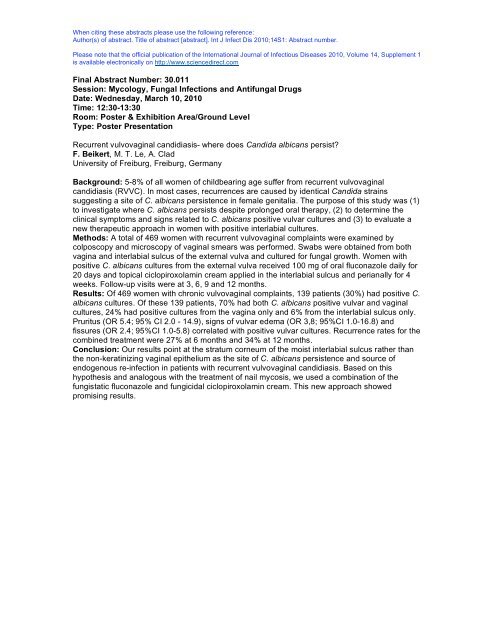14th ICID - Poster Abstracts - International Society for Infectious ...
14th ICID - Poster Abstracts - International Society for Infectious ...
14th ICID - Poster Abstracts - International Society for Infectious ...
Create successful ePaper yourself
Turn your PDF publications into a flip-book with our unique Google optimized e-Paper software.
When citing these abstracts please use the following reference:<br />
Author(s) of abstract. Title of abstract [abstract]. Int J Infect Dis 2010;14S1: Abstract number.<br />
Please note that the official publication of the <strong>International</strong> Journal of <strong>Infectious</strong> Diseases 2010, Volume 14, Supplement 1<br />
is available electronically on http://www.sciencedirect.com<br />
Final Abstract Number: 30.011<br />
Session: Mycology, Fungal Infections and Antifungal Drugs<br />
Date: Wednesday, March 10, 2010<br />
Time: 12:30-13:30<br />
Room: <strong>Poster</strong> & Exhibition Area/Ground Level<br />
Type: <strong>Poster</strong> Presentation<br />
Recurrent vulvovaginal candidiasis- where does Candida albicans persist?<br />
F. Beikert, M. T. Le, A. Clad<br />
University of Freiburg, Freiburg, Germany<br />
Background: 5-8% of all women of childbearing age suffer from recurrent vulvovaginal<br />
candidiasis (RVVC). In most cases, recurrences are caused by identical Candida strains<br />
suggesting a site of C. albicans persistence in female genitalia. The purpose of this study was (1)<br />
to investigate where C. albicans persists despite prolonged oral therapy, (2) to determine the<br />
clinical symptoms and signs related to C. albicans positive vulvar cultures and (3) to evaluate a<br />
new therapeutic approach in women with positive interlabial cultures.<br />
Methods: A total of 469 women with recurrent vulvovaginal complaints were examined by<br />
colposcopy and microscopy of vaginal smears was per<strong>for</strong>med. Swabs were obtained from both<br />
vagina and interlabial sulcus of the external vulva and cultured <strong>for</strong> fungal growth. Women with<br />
positive C. albicans cultures from the external vulva received 100 mg of oral fluconazole daily <strong>for</strong><br />
20 days and topical ciclopiroxolamin cream applied in the interlabial sulcus and perianally <strong>for</strong> 4<br />
weeks. Follow-up visits were at 3, 6, 9 and 12 months.<br />
Results: Of 469 women with chronic vulvovaginal complaints, 139 patients (30%) had positive C.<br />
albicans cultures. Of these 139 patients, 70% had both C. albicans positive vulvar and vaginal<br />
cultures, 24% had positive cultures from the vagina only and 6% from the interlabial sulcus only.<br />
Pruritus (OR 5.4; 95% CI 2.0 - 14.9), signs of vulvar edema (OR 3,8; 95%CI 1.0-16.8) and<br />
fissures (OR 2.4; 95%CI 1.0-5.8) correlated with positive vulvar cultures. Recurrence rates <strong>for</strong> the<br />
combined treatment were 27% at 6 months and 34% at 12 months.<br />
Conclusion: Our results point at the stratum corneum of the moist interlabial sulcus rather than<br />
the non-keratinizing vaginal epithelium as the site of C. albicans persistence and source of<br />
endogenous re-infection in patients with recurrent vulvovaginal candidiasis. Based on this<br />
hypothesis and analogous with the treatment of nail mycosis, we used a combination of the<br />
fungistatic fluconazole and fungicidal ciclopiroxolamin cream. This new approach showed<br />
promising results.
















